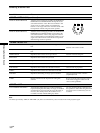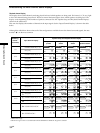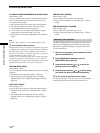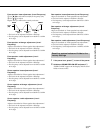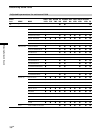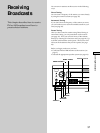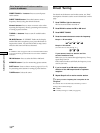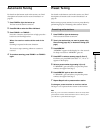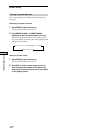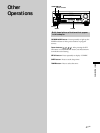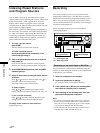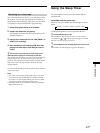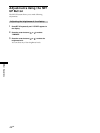
38
EN
Receiving Broadcasts
Brief descriptions of buttons used to
receive broadcasts
PRESET TUNING +/– buttons: Press to scan all preset
radio stations.
DIRECT TUNING button: Press this button to enter a
frequency directly using the numeric buttons.
Numeric buttons: Press to enter a numeric value when
inputting the frequency directly, presetting radio stations,
or tuning to preset stations.
TUNING +/– buttons: Press to scan all available radio
stations.
FM MODE button: If “STEREO” flashes in the display
and the FM stereo reception is poor, press this button to
improve the sound. You will not be able to enjoy stereo
effect but the sound will be less distorted.
Note
If “STEREO” does not appear at all even when the FM broadcast
is received normally, press this button to turn on the “STEREO”
indication.
FM/AM button: Press to select the FM or AM band.
MEMORY button: Uses for memorizing preset stations.
SHIFT button: Press to select a memory page (A, B, or C)
for presetting radio stations or tuning to preset stations.
TUNER button: Selects the tuner.
Direct Tuning
For details on the buttons used in this section, see “Brief
descriptions of buttons used to receive broadcasts” on this
page.
1 Press TUNER to light the button up.
The last received station is tuned in.
2 Press FM/AM to select the FM or AM band.
3 Press DIRECT TUNING.
4 Press the numeric buttons to enter the frequency.
Example 1: FM 102.50 MHz
05201
bbbb
Example 2: AM 1350 kHz
(You don’t have to enter the last “0.”)
531
bb
If you cannot tune in a station and the
entered numbers flash
Make sure you’ve entered the right frequency. If not,
repeat Steps 3 and 4.
If the entered numbers still flash, the frequency is not
used in your area.
5 If you’ve tuned in an AM station, adjust the
direction of the AM loop antenna for optimum
reception.
6 Repeat Steps 2 to 5 to receive another station.
z
If you try to enter a frequency that is too precise for the
tuning scale
The entered value is automatically rounded up or down.
Tuning scale for direct tuning is:
FM: 50 kHz
AM: 9 kHz (to change to 10 kHz, see page 48.)



